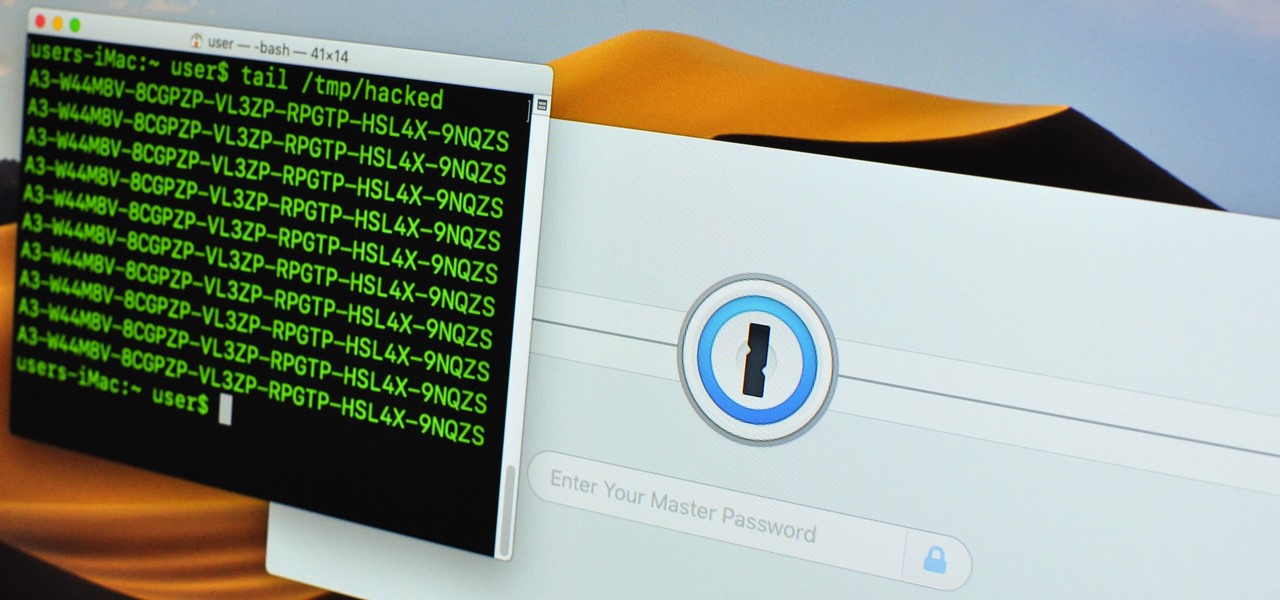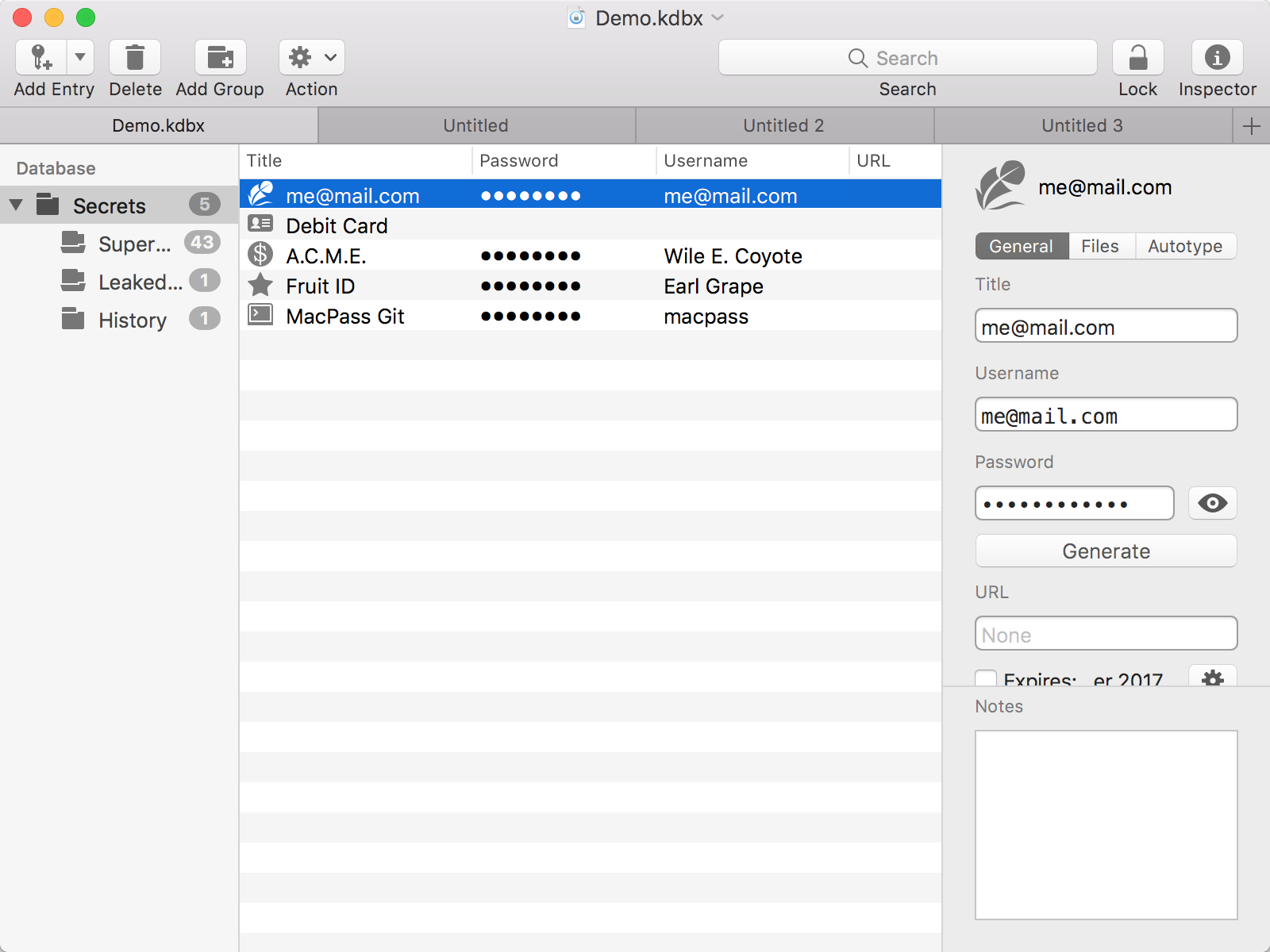MacPass is free, open source software licensed under the GPLv3. It's build using other open source software like TransformerKit, KeePassKit, KissXML, Sparkle and a lot more. The source code is available on GitHub. Passware Kit 2018 v3 recovers passwords for macOS Mojave keychains, MS Office 2019 files, and QuickBooks 2019 databases. Passware Kit 2018 v2 becomes the first commercial forensic software to recover passwords for Bitcoin wallets. It also features instant decryption of APFS disks via analysis of iCloud or iTunes backups. Pre-Releases and Snapshots. We offer the ability to easily test upcoming releases without having to setup your own build environment. Pre-Releases will be posted to our GitHub releases page. KeePass Launcher 3.0.1 Download Link. Anybody succeeded with enabling integration of eePassXC-Browser plugin on Brave browser on MacOS mojave with KeePassXC app?
We are happy to announce KeePassXC 2.4.1, the first maintenance release of the 2.4 series!
The new release fixes several bugs introduced in the previous feature release,including a case of possible data loss when unsafe saves were disabled onmacOS and an issue with reading legacy keyfiles preventing the user fromopening their database.
Other notable changes are a crash fix when editing the master key, macOS Mojavedark mode enhancements, various KeeShare fixes, restoration of the previousCtrl+C behavior for copying entries while searching, as well as tab order andnavigation / UX improvements.
We also fixed a compilation error with older GCC versions, so PPA users on UbuntuXenial (and Trusty for that matter) are able to enjoy the new release as well.
The new release can be downloaded from ourdownloads page, ourUbuntu PPA,and Snapcraft.
Changelog
Here is the full changelog for KeePassXC 2.4.1:
- Fix database deletion when using unsafe saves to a different file system [#2889]
- Fix opening databases with legacy key files that contain ‘/’ [#2872]
- Fix opening database files from the command line [#2919]
- Fix crash when editing master key [#2836]
- Fix multiple issues with apply button behavior [#2947]
- Fix issues on application startup (tab order, –pw-stdin, etc.) [#2830]
- Fix building without WITH_XC_KEESHARE
- Fix reference entry coloring on macOS dark mode [#2984]
- Hide window when performing entry auto-type on macOS [#2969]
- Improve UX of update checker; reduce checks to every 7 days [#2968]
- KeeShare improvements [#2946, #2978, #2824]
- Re-enable Ctrl+C to copy password from search box [#2947]
- Add KeePassXC-Browser integration for Brave browser [#2933]
- SSH Agent: Re-Add keys on database unlock [#2982]
- SSH Agent: Only remove keys on app exit if they are removed on lock [#2985]
- CLI: Add –no-password option [#2708]
- CLI: Improve database extraction to XML [#2698]
- CLI: Don’t call mandb on build [#2774]
- CLI: Add debug info [#2714]
- Improve support for Snap theming [#2832]
- Add support for building on Haiku OS [#2859]
- Ctrl+PgDn now goes to the next tab and Ctrl+PgUp to the previous
- Fix compiling on GCC 5 / Xenial [#2990]
- Add .gitrev output to tarball for third-party builds [#2970]
- Add WITH_XC_UPDATECHECK compile flag to toggle the update checker [#2968]
Do you usually set your Mac to remember and auto-fill passwords? Well, while doing that can be quite handy, sometimes, having your passwords auto-completed has drawbacks, especially when you actually need to remember and type them manually. Luckily, it is possible to view saved passwords on Mac. With password managers for Mac like Keychain, you can remember your app, website, account, or WiFi passwords.

Find Passwords Using Keychain


Keychain is a built-in password manager, which stores different types of Mac passwords. Here’s how to find passwords on a Mac using Keychain:
- Navigate to Keychain Access by pressing Command + Space keys and then typing Keychain in Spotlight’s search bar.
- Check the sidebar on your left and go to Category. Click on Passwords.
- Scroll up and down to look for the password you need.
- If you have changed a password many times before, there will be a few dates associated with it. Just double-click on the most recent result.
- Notice the box beside Show Password. Click on it.
- Enter the password you use to log onto your computer.
- At this point, the password will be shown.
Find WiFi Passwords on Your Mac
If you forgot about your WiFi password and a visitor asks for it, you can use this method to retrieve your WiFi password. Just make sure you know the name of your WiFi network.
- Go to Keychain Access by using the Command + Space keys to open Spotlight. Once open, enter ‘Keychain’ into the search bar.
- While in Keychain Access, search for your network’s name.
- Double-click on the most relevant result that shows.
- This time, when you click Show Password, you will be asked to enter your admin username and password. If you forgot your username, click on the Apple logo at the top of your screen and check the username of the account you are currently logged in as.
- Now, the password will show in the box beside Show Password.
Reveal Login Username and Passwords for Websites in Safari
While Safari makes it easy for you to remember your username and password for a specific website by filling them for you, sometimes, you just need to enter them yourself. Just in case you forgot your usernames and passwords, Safari has most likely saved them all for you. Here’s how you can reveal your usernames and passwords in Safari:
- Open the Safari app.
- Go to Safari menu and click Preferences > Passwords.
- Click the checkbox beside Show passwords for selected websites. Take note that doing this will require an administrator password to be entered.
- Select the website whose password you want to reveal from the list.
- Click Allow if permission is requested.
- The login details for that website should now be revealed.
- You may repeat these steps to reveal other website logins that have been stored within Safari.
- Once you’ve obtained the password you need, you can uncheck the box beside Show passwords for selected websites for security purposes. You may also choose to Remove passwords from the list if you do not want them saved by Safari.
Other Popular Password Managers for Mac
Keychain Access sure does offer lots of significant benefits to average Mac users, but sometimes, there’s just too many passwords to manage. Fortunately, some apps are designed to resolve this issue, as they help Mac users organize and store passwords. These apps are called password managers. Below, we list five of the best password manager apps for Mac today:
1. Dashlane
Aside from being a secure digital wallet, Dashlane works as a password manager. This fantastic app comes in a free version, but it can be upgraded to a Premium version with more features, such as the ability to support different platforms and handle a multitude of devices in sync.
To access Dashlane, you merely need to use one master password, which is not stored nor recorded. After that, you will have access to a secure system that stores and secures data using AES-256 encryption.
Dashlane has many other notable features, such as two-factor authentication, automatic password generation, a dashboard, security breach alerts, secure backup, and a quarterly report on the analysis of security policy.
As mentioned above, this app is not just a password manager. It can be used as a digital wallet for storing bank account details, ID information, personal details, and even credit card information. Since it is easy and efficient to use, the New York Times described Dashlane as one of the best password managers for Mac today.
2. LastPass
Developed by LogMeIn Inc., LastPass is a versatile password manager for Mac. Though it’s a free commercial software app, it also comes with a Premium version that works with iOS, Android, and OS X. The best thing about this password manager is it has many exciting features, including the capacity to auto-fill passwords on websites, as well as personal information in forms. It also has a password generator that helps users to create secure passwords using a combination of characters. If you are looking for a reliable yet free password manager for Mac, then LastPass is a good choice.

3. KeePassX
Another reliable password manager for Mac is KeePassX. It is an open source and free app that comes in two versions: installable and portable. It has built-in features and capabilities that made it one of the best password managers for Mac today. Apart from password safekeeping, it works with third-party tools and plug-ins and can generate secure passwords. Interestingly, its functionalities can also be extended to other devices, platforms, and browsers. Initially, this password manager was created by an open-source community for Windows. They called it KeePass. It’s just recently when its domain was extended to OS X devices, making it a multi-platform app.
4. 1Password

While 1Password is a paid commercial tool, it can be used for free within a 30-day trial period. The concept of this password keeper is to let Mac users remember only one password, which is called the master password. Once logged in, users can access the database of the tool itself, where passwords are stored and secured using AES-256 encryption.
Another great feature of 1Password is that it also safekeeps documents, credit card information, PIN codes, and many more. This tool can be integrated with web browsers, too. That way, it will be easier to generate passwords for online account registrations or filling in personal information or credit card details.
Wrapping Up
Keepass Move Accounts Between Databases
Take note that you are dealing with crucial information here, so you have to be extra careful while revealing or storing passwords and other information with password managers like Keychain. Sure, the details you saved on these password managers may be protected, but you never know if there are prying eyes around you. Before you find passwords on your Mac, be sure nobody is around you.
Now that you’ve obtained the information you need, it’s time to improve your Mac’s performance with Tweakbit MacRepair. With this tool installed on your Mac, you can resolve potential issues and perform quick fixes so you can use your computer at its best.
Keepass Mojave Drive
See more information about Outbyte and uninstall instructions. Please review EULA and Privacy Policy.
